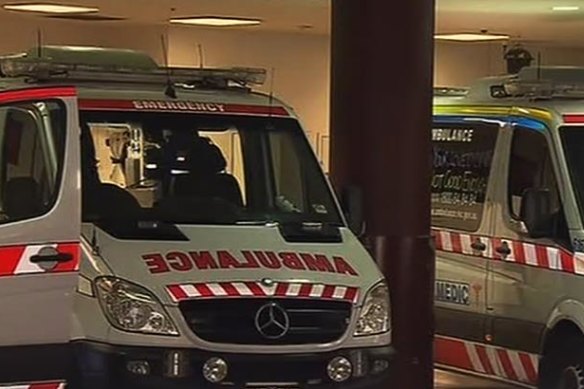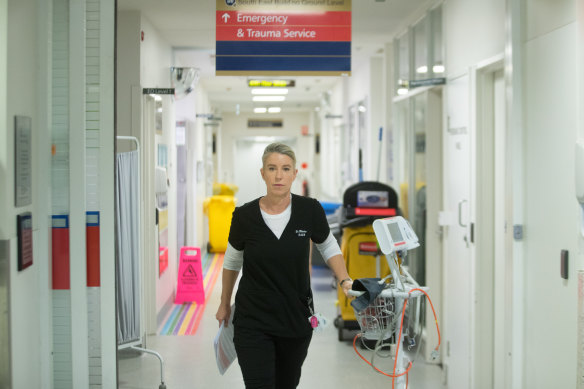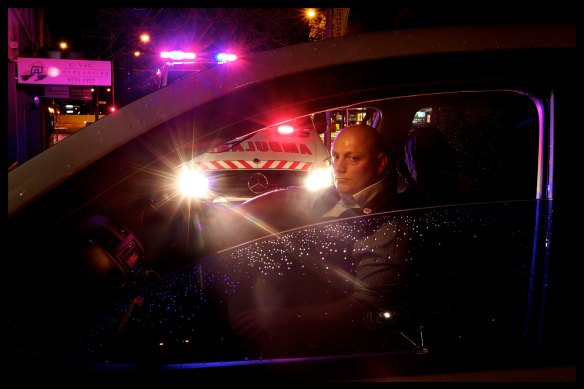- Exclusive
- National
- Victoria
- Healthcare
This was published 4 years ago
Five-hour ambulance delays outside hospitals a ‘public health disaster’
By Paul Sakkal
Patients with heart attack symptoms and spinal injuries are being forced to wait in ambulances outside hospitals for as long as five hours in what paramedics and the Australian Medical Association have described as a deadly public health emergency.
A letter from a senior Ambulance Victoria executive, obtained by The Age, and new figures reveal a health system under duress.

Ambulances have had to wait for hours outside Victorian hospitals.
Ambulance response times are at their worst since 2016-17 and Ambulance Victoria has instigated emergency protocols – where patients can be instructed to take taxis to hospital instead of waiting for ambulances – three times more this year than in the previous two years combined.
The association’s Victorian emergency medicine specialist Sarah Whitelaw said some physicians believed the system was at its worst point in three decades. “It’s been building for years and it’s not as sexy as COVID but it is an acute public health disaster,” she said.
“We will look back on this period and find there have been deaths associated with the situation.”
Emergency departments are being inundated with patients due to unseasonal spikes in respiratory viruses and gastro and people with COVID-19 symptoms are being forced to go to hospital because public health rules prevent them from seeing their GP.

Emergency department doctor Sarah Whitelaw at the Royal Melbourne HospitalCredit: Simon Schluter
Many people did not follow their regular health, medication and mental health plans during the pandemic and three month-lockdown, which Victorian Ambulance Union secretary Danny Hill says is causing a wave of patients needing emergency treatment.
Crowded emergency departments, staff shortages and a lack of beds are combining to slow the process of people moving to non-emergency wards. This phenomenon, referred to as “access block”, is clogging emergency departments and causing ambulances with sick patients to wait for hours outside hospitals, known as “ramping”.
At 10.40pm on Monday, 120 ambulances were ramped across Victoria, including 17 crews at the Northern Hospital and 14 crews at Box Hill. There are anywhere between 300-400 crews in operation at any one time, meaning a large chunk of the state’s total capacity was offline because they were waiting in queues.
Often there are about 100 ambulances either responding to an incident or on their way to an incident and the proportion of emergency vehicles available to respond to an incident has been falling to as low as 20 per cent, Mr Hill says.

Ambulance union leader Danny Hill. Credit: Simon O’Dwyer
In incidents from Monday night reported to the paramedics union: a Box Hill crew responded to just two incidents over a 12-hour shift because it spent most of its time ramped; a patient spent almost four hours ramped at the Royal Melbourne Hospital with symptoms of a heart attack and a crew spent almost five hours ramped at the Northern hospital with a patient who was immobilised with spinal injuries.
A non-emergency ambulance responded to an incident this week in which an elderly man had fallen 1.5 metres from a ladder and hit his head. Paramedics requested an emergency crew but were informed that none were available. They waited two hours for another non-emergency crew to assist with treating the man, before being ramped at a hospital for 45 minutes.
“The presentation to [emergency departments] is starting to cripple the system,” Mr Hill said.
“I think we’ve actually passed the tipping point.”
In the December quarter, ambulances responded to serious code red incidents within 15 minutes about 79.3 per cent of the time, meaning one patient in five did not receive timely care. In 2018-19, this figure was 84 per cent, short of the 85 per cent target.
The Andrews government was steadily improving response times from the low of 74 per cent in 2014 under the Napthine Coalition government, when then-opposition leader Daniel Andrews blamed Premier Denis Napthine personally for deaths caused by wait times.
Mr Hill said he expected the figures for the March quarter to be worse than last quarter’s, and said there was “no question” response time would plummet to a new low if immediate measures were not taken.
In a letter obtained by The Age, Ambulance Victoria chief operating officer Mark Rogers wrote that demand had risen to a “particularly challenging” level in February and March which he said was constricting ambulance availability.
Mr Rogers confirmed Ambulance Victoria had launched as many emergency escalations in the financial year to March as it had done for the whole of the last financial year.
These “code red” or orange protocols – where people may be directed to take taxis to hospital and non-emergency vehicles can be used for emergency events – are typically used for one-off events such as bushfires or thunderstorm asthma but are now commonly being used to meet high demand unrelated to emergency incidents.
Escalations were used for non-emergency instances of high demand nine times over the course of 2019 and 2020, but have been used for this purpose 27 times this year.
Mr Hill said paramedics had noted an “enormous” impact of pandemic-induced lockdowns that caused people with, for example, diabetes, arthritis or pulmonary disease to skip doctors appointments and stop proactively addressing their health. He called for policies to divert people away from emergency departments, including expanding referrals.
“Now people are out and about, they’re unwell and not on top of their health ... And if you’re behind in your health, you call 000 instead of going to a pharmacist.”
Dr Whitelaw – who, along with Mr Hill, said staff morale was very low – said workforce shortages meant some hospitals were not utilising all their beds. The lack of beds coupled with unseasonable spikes of some illnesses and COVID-19 protocols turning symptomatic people away from GPs was causing a severe crush, she said. Elective surgery backlogs are also curtailing the availability of beds.
“We haven’t understood how close we were to a crisis before COVID with normal demand outweighing health system capacity,” she said.
“We are incredibly nervous going into winter. Even with no COVID, no flu ... we are tipping over the edge.
“We need to snap back into public health disaster mode because this is a public health disaster.”
A Victorian government spokeswoman said demand for ambulances had increased since last year’s lockdown ended. Callouts increased from 68,500 to 78,500 from the September quarter to the December quarter last year.
“Ambulance Victoria provides some of the highest levels of care in the world and we’re grateful for the incredible work they do, particularly during the pandemic,” the spokeswoman said, adding the government spent an additional $14.8 million last year on boosting ambulance services.
Start your day informed
Our Morning Edition newsletter is a curated guide to the most important and interesting stories, analysis and insights. Sign up here.